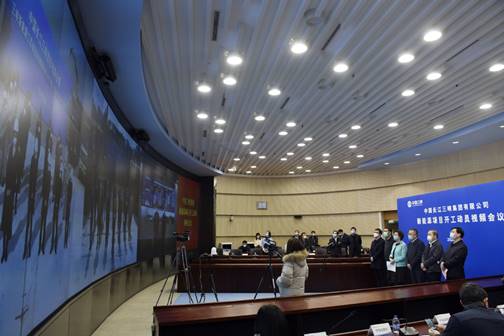
China Three Gorges
Corp, the builder and operator of the world's biggest hydroelectric power
project-the Three Gorges Dam-has been stepping up the
construction of its key domestic projects to support the resumption of
operations, amid the coronavirus outbreak. [Photo/Xinhua]
China Three Gorges Corp, the builder and operator of the world's
biggest hydroelectric power project-the Three Gorges Dam-has
been stepping up the construction of its key domestic projects to support the
resumption of operations, amid the coronavirus outbreak.
Baihetan Hydropower Station, the world's second-largest
hydropower project located on the border of Sichuan and Yunnan provinces, has
been under construction while under epidemic control. While some of the
projects are behind schedule compared with the previous quarter, the
corporation is planning to further optimize work procedures and allocate more
resources to ensure that the annual targets are achieved for the hydropower
station project. The project is expected to be completed by 2022.
Its Wudongde Hydropower Station, the fourth-biggest domestic
hydropower station and the world's seventh-largest, is also under construction
with the use of cutting-edge intelligent technologies, including real-time
temperature monitoring and intelligent grouting equipment.
It is dubbed the "smartest" mega hydropower station in
the world with the highest level of intelligent construction in China's dam
industry, including thermometers and cooling pipes in the concrete to detect
the concrete temperature in real time and the intelligent water flow system to
automatically adjust the flow to realize the cooling process of concrete in an
intelligent way. The hydropower station is expected to see its first batch of generator
sets put into production in July and be able to generate 38.9 billion kilowatts
of electricity every year after its 12 generating units start operation.
Xiluodu Hydropower Station and Xiangjiaba Hydropower Station,
together with Baihetan and Wudongde hydropower stations, will form a cascade of
power stations on the Jinsha River, a cluster that is expected to reach an
installed capacity of 46.46 million kilowatts, equivalent to twice the output
of the Three Gorges Dam in the middle reaches of the Yangtze, and will generate
about 190 billion kilowatt-hours of electricity annually.
The Three Gorges Reservoir in Central China's Hubei province has
also raised its discharge volume to ensure water and power supply as the
outbreak has affected coal reserves and coal-fired power generation in the
province.
Industry insiders say they believe the corporation plays a vital
role in ensuring power supply in the fight against the outbreak.
Efforts of the State-owned energy companies can ensure that
power supply plays a vital role in the combat against the outbreak, said Lin
Boqiang, head of the China Institute for Studies in Energy Policy at Xiamen
University.
The average flow of the Yangtze River in Yichang, where the
reservoir is located, was recorded at 8,240 cubic meters per second in January,
said the company. It is up nearly 70 percent from the average levels seen in
the previous years.
According to the Yangtze River Water Resources Committee, the
average inbound flow at the reservoir in January reached 5,850 cubic meters per
second, while the outbound flow reached 7,850 cubic meters per second, meaning
the discharge volume reached 2,000 cubic meters per second in the month. The
reservoir will maintain an outbound flow of approximately 7,000 cubic meters
per second in early February.
The increased discharge ensured the water and power supply in
the downstream areas and also met the shipping demand during the drought
season, it said.
Source:CHINA DAILY







